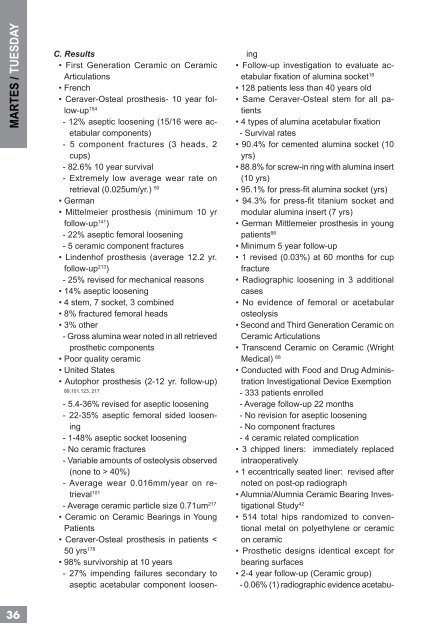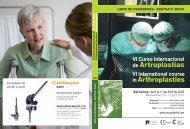cadera / hip - Active Congress.......
cadera / hip - Active Congress.......
cadera / hip - Active Congress.......
Create successful ePaper yourself
Turn your PDF publications into a flip-book with our unique Google optimized e-Paper software.
MARTES / TUESDAY<br />
36<br />
C. Results<br />
• First Generation Ceramic on Ceramic<br />
Articulations<br />
• French<br />
• Ceraver-Osteal prosthesis- 10 year follow-up<br />
154<br />
- 12% aseptic loosening (15/16 were acetabular<br />
components)<br />
- 5 component fractures (3 heads, 2<br />
cups)<br />
- 82.6% 10 year survival<br />
- Extremely low average wear rate on<br />
retrieval (0.025um/yr.) 50<br />
• German<br />
• Mittelmeier prosthesis (minimum 10 yr<br />
follow-up 141 )<br />
- 22% aseptic femoral loosening<br />
- 5 ceramic component fractures<br />
• Lindenhof prosthesis (average 12.2 yr.<br />
follow-up 213 )<br />
- 25% revised for mechanical reasons<br />
• 14% aseptic loosening<br />
• 4 stem, 7 socket, 3 combined<br />
• 8% fractured femoral heads<br />
• 3% other<br />
- Gross alumina wear noted in all retrieved<br />
prosthetic components<br />
• Poor quality ceramic<br />
• United States<br />
• Autophor prosthesis (2-12 yr. follow-up)<br />
89,101,123, 217<br />
- 5.4-36% revised for aseptic loosening<br />
- 22-35% aseptic femoral sided loosening<br />
- 1-48% aseptic socket loosening<br />
- No ceramic fractures<br />
- Variable amounts of osteolysis observed<br />
(none to > 40%)<br />
- Average wear 0.016mm/year on retrieval<br />
101<br />
- Average ceramic particle size 0.71um 217<br />
• Ceramic on Ceramic Bearings in Young<br />
Patients<br />
• Ceraver-Osteal prosthesis in patients <<br />
50 yrs 178<br />
• 98% survivors<strong>hip</strong> at 10 years<br />
- 27% impending failures secondary to<br />
aseptic acetabular component loosen-<br />
ing<br />
• Follow-up investigation to evaluate acetabular<br />
fi xation of alumina socket 18<br />
• 128 patients less than 40 years old<br />
• Same Ceraver-Osteal stem for all patients<br />
• 4 types of alumina acetabular fi xation<br />
- Survival rates<br />
• 90.4% for cemented alumina socket (10<br />
yrs)<br />
• 88.8% for screw-in ring with alumina insert<br />
(10 yrs)<br />
• 95.1% for press-fi t alumina socket (yrs)<br />
• 94.3% for press-fi t titanium socket and<br />
modular alumina insert (7 yrs)<br />
• German Mittlemeier prosthesis in young<br />
patients 88<br />
• Minimum 5 year follow-up<br />
• 1 revised (0.03%) at 60 months for cup<br />
fracture<br />
• Radiographic loosening in 3 additional<br />
cases<br />
• No evidence of femoral or acetabular<br />
osteolysis<br />
• Second and Third Generation Ceramic on<br />
Ceramic Articulations<br />
• Transcend Ceramic on Ceramic (Wright<br />
Medical) 68<br />
• Conducted with Food and Drug Administration<br />
Investigational Device Exemption<br />
- 333 patients enrolled<br />
- Average follow-up 22 months<br />
- No revision for aseptic loosening<br />
- No component fractures<br />
- 4 ceramic related complication<br />
• 3 c<strong>hip</strong>ped liners: immediately replaced<br />
intraoperatively<br />
• 1 eccentrically seated liner: revised after<br />
noted on post-op radiograph<br />
• Alumnia/Alumnia Ceramic Bearing Investigational<br />
Study 42<br />
• 514 total <strong>hip</strong>s randomized to conventional<br />
metal on polyethylene or ceramic<br />
on ceramic<br />
• Prosthetic designs identical except for<br />
bearing surfaces<br />
• 2-4 year follow-up (Ceramic group)<br />
- 0.06% (1) radiographic evidence acetabu-





